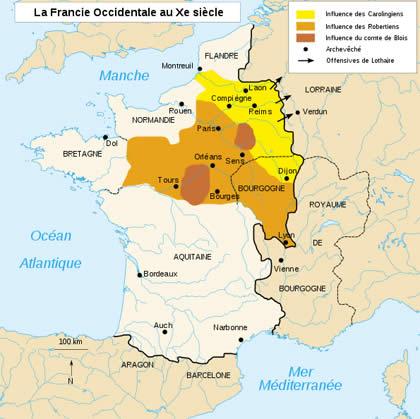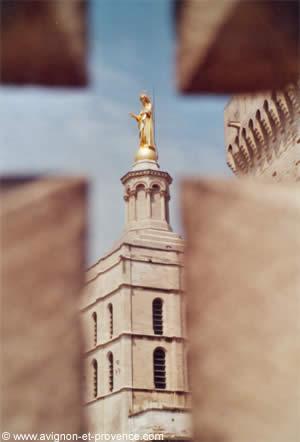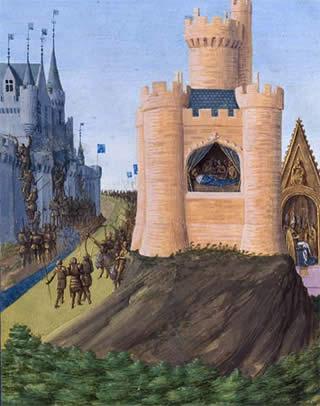

Avignon, Arles and Marseille are the three most important cities of Provence. Avignon was a "fortress city" of roman aspects. It was also a reputed intellectual center. In the year 550, the Parisian abbot Domnole refused the bishopric of Avignon because he feared "sophistic senators and philosophical magistrates."
The provençal nobility considered itself of "Roman rights." Cultured and proud, they badly withstood the Frank protectorate. It is likely that they called upon the Saracens, who entered Arles and Avignon in 734 - 735. Having become an Arab stronghold, Avignon will be retaken by Charles Martel for a first time in 737, after a bloody siege; and again a second time two years later. The city became once again the property of the Franks, and the traitors were severely chastised. The Frankish aristocracy took the country definitively in hand. In 932, the kingdom of Provence was united with Burgundy, thus forming the kingdom of Arles, attached to the empire in 1033.
In 948, the counties of Provence are regrouped under a common authority : one of the descendants of Boson, (king of Provence in 879), elected count of Arles, became the first count to govern Provence.

Parallel to the enfeeblement of royal power under the Carolingian dynasty, the nobility took control of the countryside, and lost interest in the cities. This was an epoch of feudal wars, and the absolute authority of a local seigneur over his lands. Avignon was governed by a count and a bishop nominated by the count. In the beginning of the 11th century, the count of Provence and the bishop took residence on each side of the cliff : the former in the Fort St Martin, constructed on the groundwork of the old roman castrum and destroyed in 1655, while the latter erected a chapel, Notre-Dame-du-Château. (Notre dames des Doms).
Trade flourishing in all of Western Europe, Avignon benefits from its position on the trade route between Italy and Spain, and from heavy river traffic. Craftsmen's and tradesmen's guilds developed and installed themselves at the foot of the cliff. Enriched noblemen, knights and ombudsmen gained importance and began to enjoy a non-negligible authority. The repopulated city rediscovered its gallo-roman dimensions. A double wall is built in the 12th century. The grounds around it are drained and the marshes dried up.
The power of the Vice-count, and that of the Bishop was reduced. The dynasty, founded by Boson of Arles was divided, and in the beginning of the 12th century Provence belonged to three families. Avignon, finding itself at the intersection of three counties, with none of them willing to share her, was never divided. In 1129, just before dying, William III, Count of Forcalquier granted the bishops, knights and ombudsmen of Avignon "power, jurisdiction and seigneurship", of which the vice-count had previously been invested. Avignon was thus liberated from the counts' and vice-counts' authority and set itself up as a commune. In 1161, the emperor Frederick Barbarossa confirmed this privilege.

The bishop is the president, but authority lies in the hands of 8 councilmen. (4 at the start) Four knights and four ombudsmen, elected for one year. The councilmen are assisted by judges and streetmasters. For important decisions the people were convoked at the foot of Escalier St. Anne which joins the Rhone with Notre Dame des Doms.
The famous Avignon bridge, named St Benezet Bridge in honor of its founder, was built in 1185. Its construction and maintenance costs were high, and from the 17th century on it was regularly damaged by the abrupt and violent swelling of the Rhone. It operated until 1669 when Avignon renounced the financing of its expensive maintenance. In the Middle Ages, it was the only bridge over the Rhone between the Mediterranean sea and Lyon. It also contributed to the inflow of marchandise. Commercial and cosmopolitan, Avignon was, at this time, one of the richest, most opulent and most populated cities of the Empire. Avignon's prosperity was to such an extent that she became one of the most powerful cities of the Midi.
The conflict between Raymond VI, count of Toulouse, and Louis VIII, king of France, would nevertheless upset the order of things. The commune of Avignon sided resolutely with the count of Toulouse when the Council of Lotran (1215) dispossesses him of many territories. Avignon, loyal to her suzerain, attacked William II of Orange, who wanted to appropriate the County of Venaissin. She eliminated him and received in gratitude Caumont, Le Thor, Thouzon, Jonquerette. As reimbursement of a loan, she received in 1226 the entire County of Venaissin, the chateaux of Malaucene and Beaucaire. The commune of Avignon, at the zenith of its power, carried on as a veritable feudal lord, even believing itself capable of resisting the French king.
Louis VIII arrived, coursing down the Rhone valley with an immense army, on crusade against Albigenien heretics. After some hesitation, the inhabitants closed their gates, thus denying him passage over the Rhone. The king's army laid siege, a harsh and brutal siege lasting three month from June 10 to September 12, 1226. In the end, the famished Avigonnais surrendered, just a few days before the swelling of the Rhone flooded the positions where the king and his army had held fast for so long.
The king took hostages, demanding a high ransom, ordered the destruction of the ramparts and ordered the peasants, overjoyed by the opportunity to revenge themselves on the oppressive guardianship, to dismantle the 300 stronghouses of the Avignon knights. The bridge, as well, was reduced to one fourth its span. Thus ended the power of Avignon.
In 1229, the County of Venaissin was given over to the Church. Following the death of the Count of Toulouse, Raymond VII, in 1245, the city came under the double protectorate of Charles 1st of Anjou, count of Provence, and Alphonse of Poitiers, count of Toulouse, both of them brothers of the king, Saint Louis. They restored the authority of the counts by reducing for good the power of the commune in 1251. In 1274, the king Philip the Bold, successor to his uncle Alphonse of Poitiers, dead without heirs, gave the County of Venaissin to the Church and ceded his part of Avignon in 1290 to the count of Provence Charles II of Anjou, who thereby became the sole ruler of Avignon.
Where to sleep?